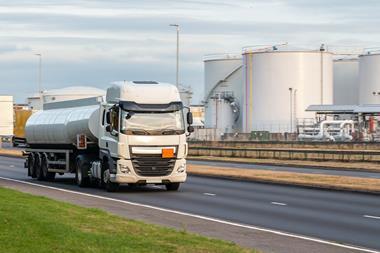Marc Bacon and Andy Price investigate the increasing risks and costs associated with employees' own cars used on business
Despite numerous reports showing driving to be among the most dangerous activities one can undertake, the attitude towards risks associated with driving remains blasé at best.
Up to five times as many employees die on the road than in a factory or an office. Yet, despite the high incident rate and the fact that the Department for Transport has officially classed driving as one of the most dangerous activities within the workplace environment, UK businesses still do not take the risk seriously enough.
It is estimated that the number of employee cars used on business has grown from an estimated 1.6 million to more than 2.1 million, over the past five years as the 'benefits in kind' tax regime pushes more companies to offer cash or personal lease vehicles rather than traditional company cars.
Worryingly, research by Zurich Risk Services reveals that at least 51% of UK businesses admit that they do not look after the specific safety needs of staff who drive private cars for work purposes. This lack of fundamental risk assessment of own-car drivers by companies means that the companies are not able to identify and manage the risks these drivers face.
Frighteningly, the obvious costs of dealing with a major collision are just the tip of the iceberg. It is the hidden costs that are the biggest issues for businesses. The Interna-tional Loss Control Institute has cited that for every £1 a company gets back from insurance there can be from £8-£32 in uninsured losses depending on the severity of a collision.
It is not uncommon to find that 5%-7% of a company's turnover can go to funding the cost of collisions. However, many UK businesses are unaware of these underlying costs which are absorbed in everyday operating costs and are rarely reflected on the balance sheet. This only serves to perpetuate the problem with little being done to improve the safety situation or to make sure that employees are taking out adequate insurance to cover the business use of their vehicles.
Businesses are leaving themselves open to the threat of substantial fines and, in extreme cases, prosecution in the event of a collision involving an employee because they are not prioritising work-related driver safety.
Furthermore, companies could be financially liable for an employee who is deemed to be at fault in a major collision. Complying with certain road traffic law requirements, for example, having valid MOT certificates and drivers' licences, is not enough to ensure the safety of employees, and others, when they are on the road, states the HSE.
According to the Driving at Work guidance on work-related road safety issued jointly by the Health and Safety Executive and the Department for Transport in September 2003:
"Health and safety law applies to on-the-road work activities as to all work activities, and the risks should be effectively managed within a health and safety management system. This guidance applies to any employer, manager or supervisor with staff who drive, or ride a motorcycle or bicycle at work, and particularly those with responsibility for fleet managment. It also applies to self-employed people."
Management support
Unfortunately, many of the businesses surveyed by Zurich are unaware of this guidance and nearly two-thirds of businesses said they have no specific budget allocated to implement and maintain a fleet risk management programme. This means that employees driving on business may not be getting the management support they need to drive safely.
The benefits of adopting a safe driving-at-work culture can be considerable. According to the HSE: "It allows you to exercise better control over costs, insurance premiums and legal fees and claims from employees and third parties.
"It also allows you to make informed decisions about matters such as driver training and vehicle purchase and helps you to identify where health and safety improvements can be made." Companies will also benefit from:
• Fewer days lost due to work injury
• Reduced risk of work-related ill health
• Reduced stress and improved morale
• Less need for investigation and paperwork
• Less lost time due to work rescheduling
• Fewer vehicles off the road for repair
• Reduced running costs through better driving standards
• Fewer missed orders and business opportunities so reduced risk of losing the goodwill of customers
• Less chance of key employees being banned from driving.
Work-related road safety can be effectively managed if it is integrated into a company's health and safety requirements and risk management programme. While this can be a huge undertaking it is something that companies do routinely for factory or office tasks because they are required to do so under current health and safety legislation.
Understanding all the risk areas is a crucial first step and companies need to assess individual, proven and organisational risks:
Organisational risks: looking at a company's safety operation and management procedures and what effect they are having on its employees' ability to drive safely. Quite often safety measures have to be implemented at an organisational rather than at an individual level to solve the problem on a long-term basis. Individual risks: this is a process of understanding the theoretical risk that exists - the possibility that something may happen in the future - by conducting thorough risk assessments of the drivers, the journeys they make and the vehicles they use. Areas looked at include driver habits and history, their minor and major collisions, their fitness to drive, mileage, roads travelled on and countries travelled in, the vehicle's fitness of purpose for that type of job, how old it is, its mileage, engine capacity and service history.
Proven risks: a collision analysis process of employees' past road traffic collisions. Often a wealth of data already exists on the types and severity of crashes and who is having them, but is not being used for risk management purposes. The deeper a company delves the more apparent the cause of such accidents will become.
Once a full understanding of all the risks is achieved appropriate control measures can be put in place to address the exposures.
The third stage is to maintain the programme and to monitor and measure progress and whether the interventions have been successful.
Finally, a review of the process will ensure that all elements are working in tandem and will also allow a business to refocus and realign a fleet risk management programme as changes occur in its operating procedure that could have a knock-on effect on safety issues.
Besides addressing the risks, a fleet risk management programme needs to have adequate insurance in place to cover claims in the event of a collision.
However, despite more privately-owned or leased cars than ever before being used for business purposes, Zurich calculates that only 30% of its customers are buying cover for business use of own cars on their employees' behalf.
Responsibilities
That leaves 70% of employers who are relying on their staff to source their own insurance. This in itself is not a problem if employees are aware of the level of cover they need to secure. Most, however, are not.
It is an employer's responsibility to educate employees on the safety issues involved, to identify an exposure and to make sure that staff understand what level of insurance they need to cover that exposure.
Extending a company's fleet insurance to cover business use of own cars is a viable option. The benefit here is that an employer can be sure that it is getting the right cover, the correct level of indemnity and that claims will be met in the event of a collision involving a vehicle being used for business purposes.
The lack of fundamental safety programmes is putting more employees and other people at risk daily and the inadequacy of insurance is exposing businesses unnecessarily to unknown liabilities.
While under-insurance is a difficult issue to overcome with legislation, enforcement action by the HSE will be taken where the police identify that serious management failures have been a significant contributory factor in the incident. IT
Mark Bacon is motor chief underwriting officer at Zurich Global Corporate in Europe and Andy Price is practice leader of motor fleet at Zurich Risk Services
Hosted by comedian and actor Tom Allen, 34 Gold, 23 Silver and 22 Bronze awards were handed out across an amazing 34 categories recognising brilliance and innovation right across the breadth of UK general insurance.













































